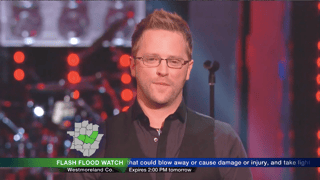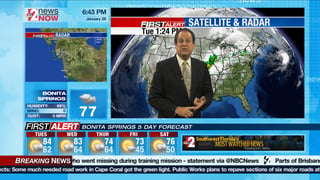 By Jason Toliopoulos
By Jason Toliopoulos
Creative Services Manager, ChyronHego
As content creators, you have a wide arsenal of tools at your disposal. Whether you’re a news director, promotions producer, or broadcast designer, you have a lot of options these days when it comes to channel branding. So how do you effectively get your message across? How do you attract your audience, and engage them?
Here, for your consideration, are the 4 Cornerstones of Channel Branding:
1. Content Priority
Let’s face it, there’s a lot on screen competing for viewers’ attention. The question you first have to ask is what it is you want them to focus on. When making decisions about priority, it’s best to think about the context in which information- and sponsorship- is being presented.
 In the case of severe weather or school closings, your viewers
In the case of severe weather or school closings, your viewers
have specific goals. Get out of the way of the tornado, or the need to know if they have to keep their kids home that day. In those contexts, they’re going to want certain information first.
But on a typical news day - with a major sponsor backing your program - you have a slightly different context. Your regular news crawl may be a key fixture of your typical news presentation, but your client will want to know that advertising with your station is a key driver in increased sales. So in this context, you might want to prioritize your sponsor.
The key to prioritizing content is to design elements to show what’s important. This is done through bold characters, your font choice, accent colors and even whether you use a crawl or a page flip effect for motion. Think about the order and placement of various elements appearing on screen. Does the message belong in a Ticker, in a snipe, or some other on-screen fixture?
2. Say What? And How to Say It!
In a medium where hyper-local information is the key to winning your market, you and your station are where your viewers turn for trusted information. So what is your message? In major cities, traffic and weather conditions will rule the day. Tide schedules may be important to your viewers because you’re in a maritime market. Soil information can be critical to rural farming communities. And up-to-the-second barometric pressure and wind speed may actually save lives in Tornado Alley.
 Once you know what you want to say, the next question is how to say it. Using principles from the first cornerstone of channel branding, you will need to prioritize your most important information. Does breaking news appear in conjunction with other content? Or is it on its own and should it be the only thing a viewer sees?
Once you know what you want to say, the next question is how to say it. Using principles from the first cornerstone of channel branding, you will need to prioritize your most important information. Does breaking news appear in conjunction with other content? Or is it on its own and should it be the only thing a viewer sees?
This is especially relevant when choosing how to incorporate paid sponsorships. The last thing you want to do is hobble your client’s message and your own. Sponsorships versus Promos? Your viewers know when something is branding or sponsored. How should you manage the need to sell, versus the need to promote, versus the need to communicate with your audience?
3. Snipes, Bugs, and Interrupts
The station bug is often considered sacrosanct. Lower 3rds are designed around it. Tickers are meant to incorporate it. And yet more and more, we’re seeing clients take these so-called rules and turn them on their heads.
 Bugs are now expected to do more than just impart the time and temp. Hashtags, web addresses and even content awareness are being built into bug programming. Bugs that promote as well as brand are becoming more and more commonplace, and with new channel branding tools hitting the market, this is now technically easier to do.
Bugs are now expected to do more than just impart the time and temp. Hashtags, web addresses and even content awareness are being built into bug programming. Bugs that promote as well as brand are becoming more and more commonplace, and with new channel branding tools hitting the market, this is now technically easier to do.
What you choose to do with your bug will affect the rest of your lower 3rd presentation. This includes promotional items, such as Snipes. If you choose to make a more active bug, then your snipes might be included in that as well. When it comes to snipes we see clients taking two general approaches – the subtle snipe and the full-lower 3rd takeover.
When deciding which type of snipe to use, your content is key. Knowing what your message is will determine how best to show it. Using a subtle snipe may work over programming that doesn’t use the lower 3rd space to present content. While a lower-3rd takeover may be needed to hide lower 3rds from programming that uses that space.
4. Tickers. All Types of Tickers!
Second only to the bug, tickers are a major component of our clients’ lower 3rd presentation. Depending on how they’re designed, tickers lend varying levels of “immediacy” to your presentation. Tickers are often both complimentary to a lower 3rd, and must compete for attention as well.
News, traffic, weather and sports are the 4 pillars of news programming, and certain presentation types lend themselves better to certain types of information.
 Crawls connote immediacy and activity. As information travels across the screen, there is an ever dwindling amount of time to catch it before it’s gone. This lends itself to active presentation types such as financial information, breaking news or emergency alerts. It also allows you to convey a larger volume of information as multiple data points could potentially be on screen at once.
Crawls connote immediacy and activity. As information travels across the screen, there is an ever dwindling amount of time to catch it before it’s gone. This lends itself to active presentation types such as financial information, breaking news or emergency alerts. It also allows you to convey a larger volume of information as multiple data points could potentially be on screen at once.
Page Flips, on the other hand, leverage short, discreet information. The movement is more subtle, and, for most viewers, the content is easier to digest as each story is its own self-contained unit. Punchy news headlines, sports scores, or even election results are all self-contained in a page flip. It’s off the screen, then on the screen, then gone.
Lately, we’re seeing clients ignore this dichotomy and blend crawls and page flips throughout their tickers. In certain cases, clients may opt to have a page flip that, if the story is too long, will crawl until completed. The key when making decisions about ticker presentation is not to see crawls and page flips as black and white, but rather to make the best determination around the content and messaging you want to convey.
Now that you know the questions to ask, collaborate with your art director and designer on creating the right channel branding that matches your station's personality. When these questions are considered thoughtfully and executed well, you'll keep your audience engaged and you'll more easily identify creative, eye-catching ways to generate additional revenue.


